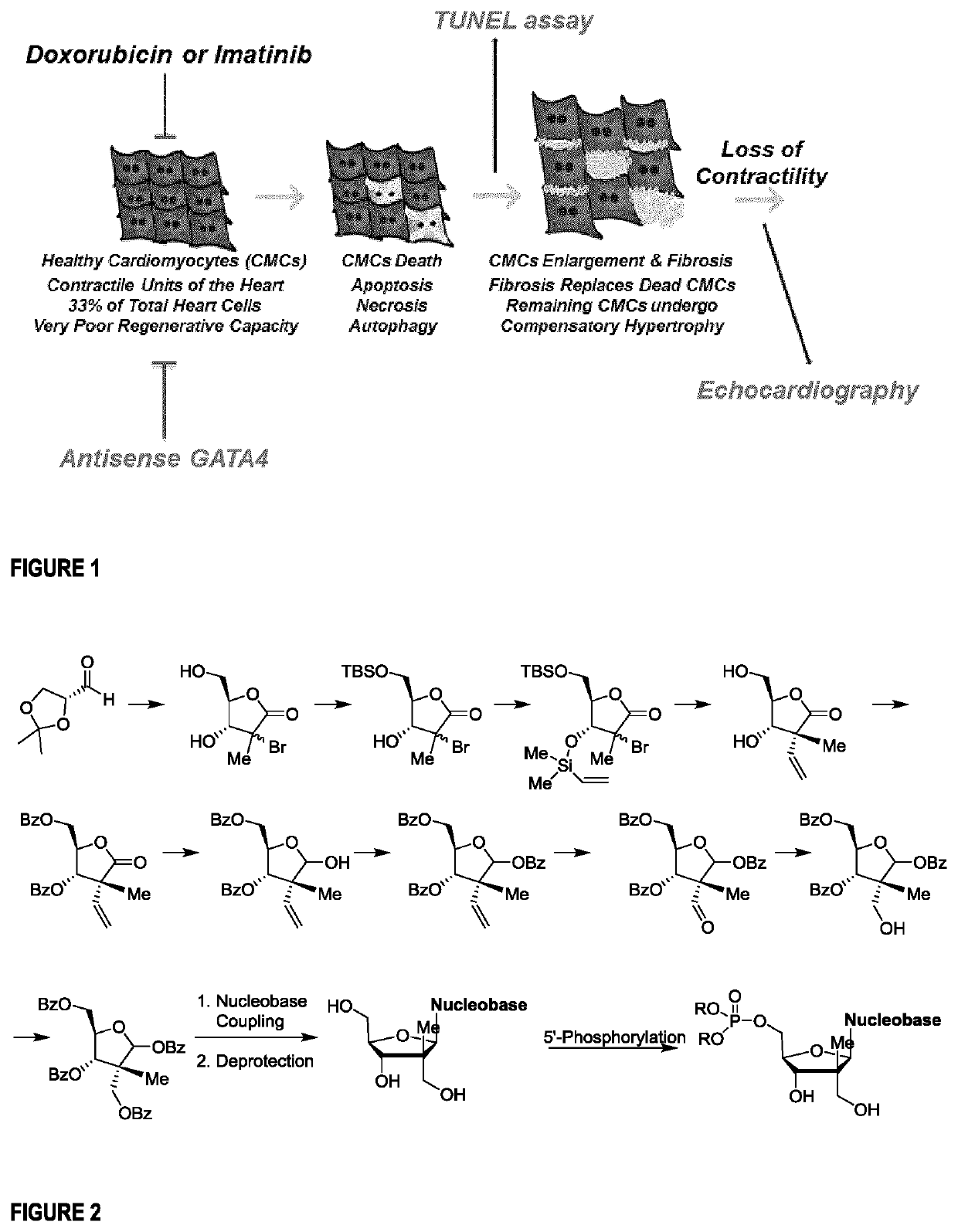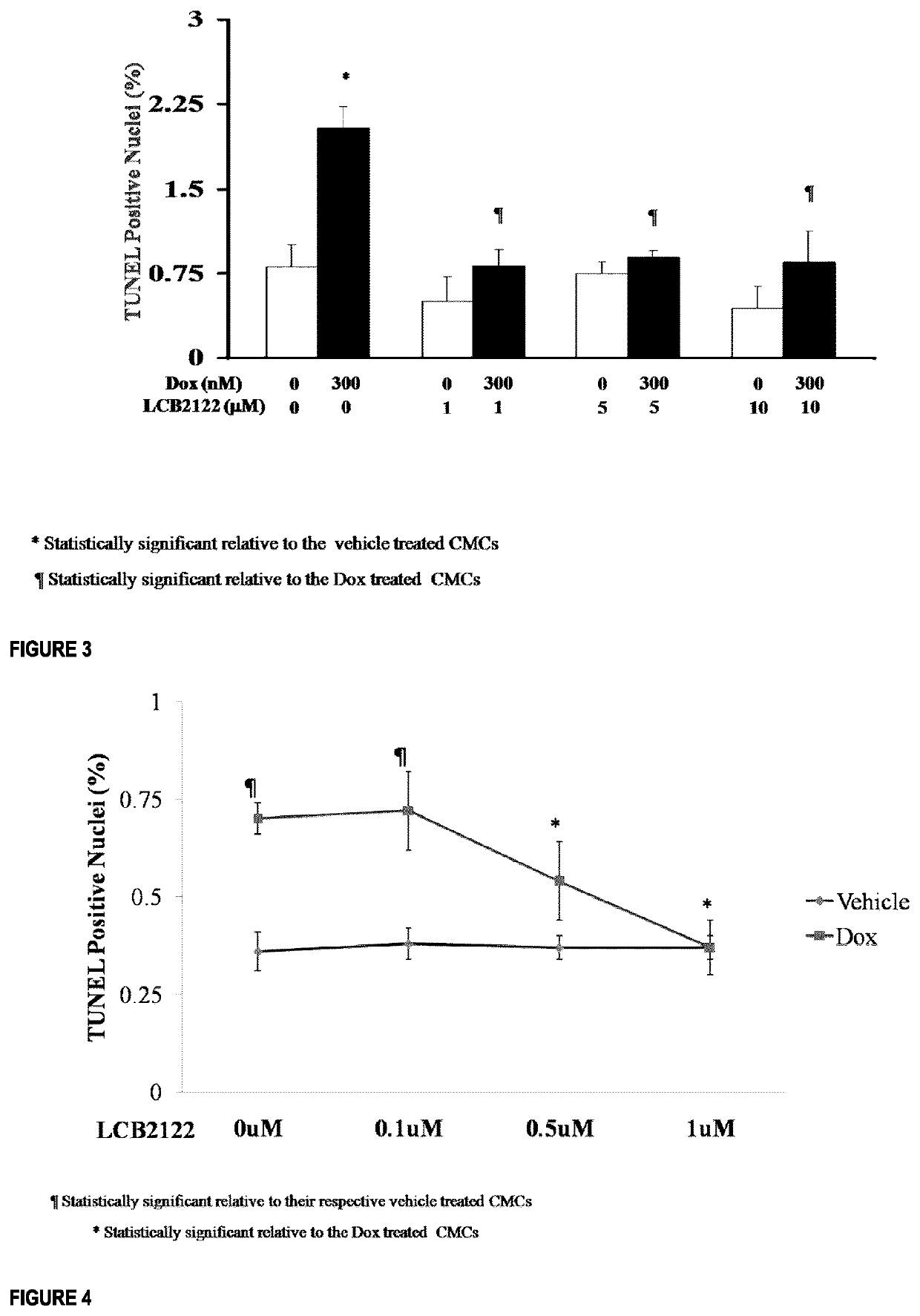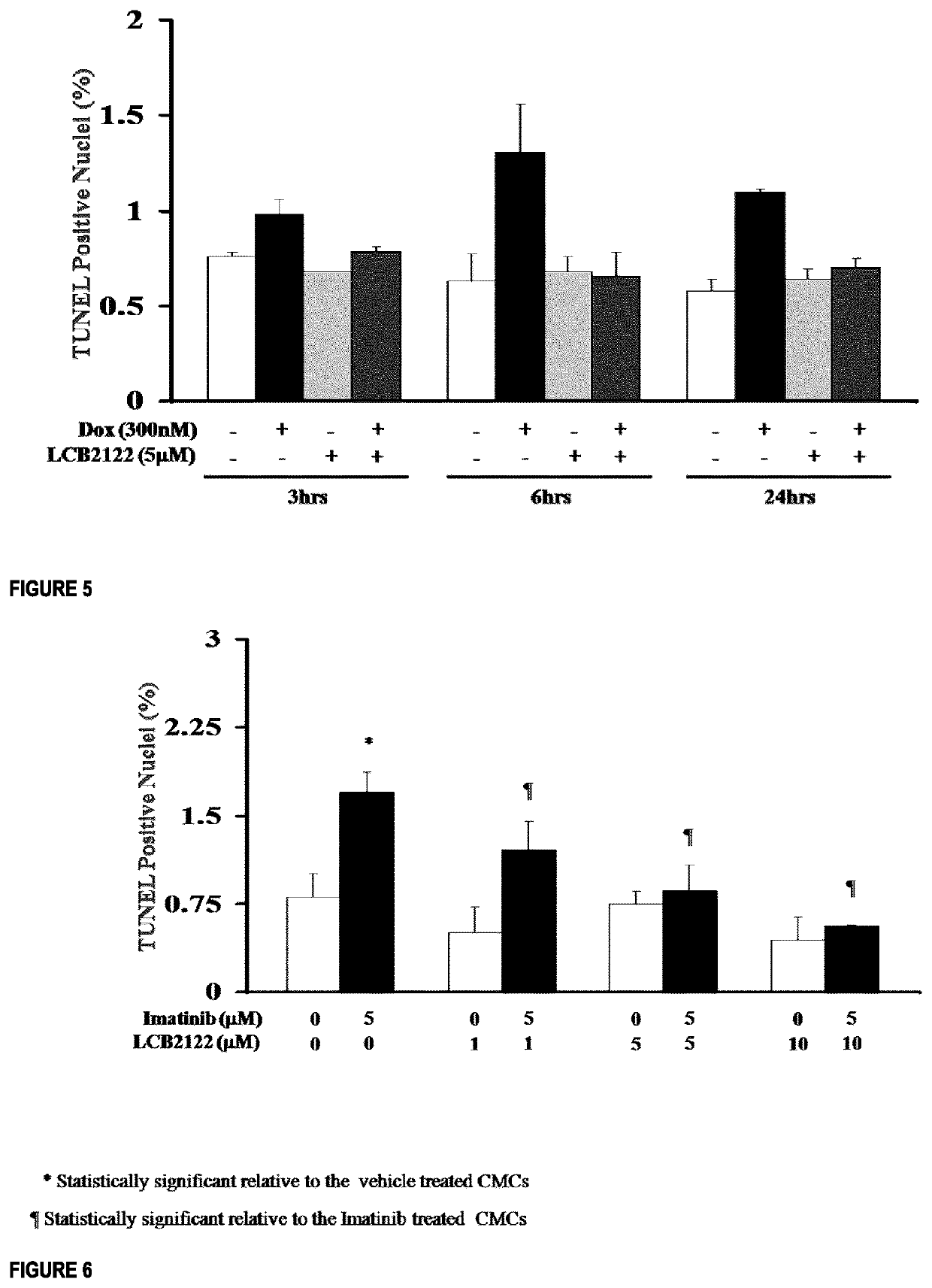Nucleoside and nucleotide analogues bearing a quaternary all-carbon stereogenic center at the 2' position and methods of use as a cardioprotective agent
a nucleotide analogue and all-carbon stereogenic technology, applied in the field of nucleoside and nucleotide analogues, can solve the problems of inability to pump blood efficiently throughout the body, inability to properly fill the heart muscle between beats, and stiff heart ventricles,
- Summary
- Abstract
- Description
- Claims
- Application Information
AI Technical Summary
Benefits of technology
Problems solved by technology
Method used
Image
Examples
example 1
tective Activity
In Vitro Experiments
[0265]In vitro experiments were carried out to test the direct effect of compounds of the invention LCB2122, LC2165, and LCB2191 on cardiomyocytes.
[0266]Primary cardiomyocyte monologues covered by serum free media (SF) were treated with DMSO (vehicle), Doxorubicin (DOX) (300 nM), Imatinib (Imat) (5 μM), and / or LCB2122 at varying concentrations (0.1, 0.5, 1.5 at 10 μM) diluted in SF for 3, 6, 18 or 24 hours. The TUNEL assay (Terminal Deoxynucleotidyltransferase mediated dUTP End Labeling) was utilized to detect apoptotic nuclei using an Apop Tag Red in Situ Apoptosis Detection Kit (Millipore, Temecula, Calif.). A Zeis fluorescent microscope was used for image acquisition. Cell counting was done using the Imager® Software.
[0267]As seen in FIGS. 3 and 4, LCB2122 completely prevented DOX-induced apoptotic cell death with an EC50 of 500 nM (FIG. 4). LCB2122 did not induce apoptosis in these cells at any time points (FIG. 5). DOX-induced apoptosis was h...
example 2
Synthesis
Example 2.1—Intermediate Compound
[0283]
(4R,5R)-3-bromo-4-hydroxy-5-(hydroxymethyl)-3-methyldihydrofuran-2(3H)-one
[0284]To a solution of precooled glyceraldehyde (24 g, 185 mmol) in dry acetonitrile (710 mL) at −10° C. under Ar, MgBr2.OEt2 (37 g, 142 mmol) is added. After 15 minutes, all the solids were in solution and neat enolate (50.7 g, 142 mmol) precooled at −20° C. was added via cannula during 10 minutes. The mixture was stirred for 23 h at 0° C., and quenched by addition of 200 mL ice-H2O at 0° C. The mixture was diluted with ethyl acetate, washed 2×200 mL with distilled water, the organic phase was dried over MgSO4, and concentrated to produce clear brown oil (50.7 g), which was used for the next step. HCl conc (10 mL, 121.8 mmol) was added dropwise to a solution of aldol adducts (50.7 g, 137 mmol) in THF (275 mL) at 0° C. and open atmosphere for 20 minutes. After 50 minutes, the reaction was warmed to room temperature. After 5 h, the reaction mixture was concentrate...
example 2.2
e Compound
[0287]
(4R,5R)-3-bromo-5-(((tert-butyldimethylsilyl)oxy)methyl)-4-hydroxy-3-methyldihydrofuran-2(3H)-one
[0288]TBSCl (12.7 g, 84.4 mmol) was added to a mixture of lactones (19 g, 84.4 mmol), and imidazole (23 g, 337.7 mmol) in dry DMF (420 mL) under Ar at −40° C. The reaction was followed by TLC, and after 5 h, 0.06 equiv of TBSCl (0.77 g, 5.10 mmol) was added. After 7 h in total, the reaction mixture was diluted with ethyl acetate (800 mL), washed sequentially with citric acid (0.1M, 400 mL), distilled water, brine, dried over MgSO4 and concentrated to produce a brown oil (27 g, 94% yield). Rf=0.37 (30% ethyl acetate in hexanes); IR (neat) 3457, 2952, 2931, 2855, 1771, 1256, 1132 cm−1; Formula C12H23BrO4Si; MW 339.2981; For major diastereomer from 3,4-anti aldol adduct: 1H NMR (500 MHz, CDCl3) δ 4.13 (dt, J=8.1, 2.8 Hz, 1H), 4.01 (dd, J=12.1, 2.5 Hz, 1H), 3.94-3.83 (m, 2H), 1.94 (s, 3H), 0.95-0.82 (m, 9H), 0.08 (d, J=7.8 Hz, 6H); 13C NMR (125 MHz, CDCl3) δ 171.5, 82.7, 74.0...
PUM
| Property | Measurement | Unit |
|---|---|---|
| body weight | aaaaa | aaaaa |
| temperature | aaaaa | aaaaa |
| temperature | aaaaa | aaaaa |
Abstract
Description
Claims
Application Information
 Login to View More
Login to View More - R&D
- Intellectual Property
- Life Sciences
- Materials
- Tech Scout
- Unparalleled Data Quality
- Higher Quality Content
- 60% Fewer Hallucinations
Browse by: Latest US Patents, China's latest patents, Technical Efficacy Thesaurus, Application Domain, Technology Topic, Popular Technical Reports.
© 2025 PatSnap. All rights reserved.Legal|Privacy policy|Modern Slavery Act Transparency Statement|Sitemap|About US| Contact US: help@patsnap.com



